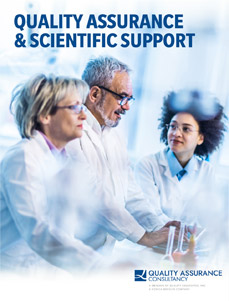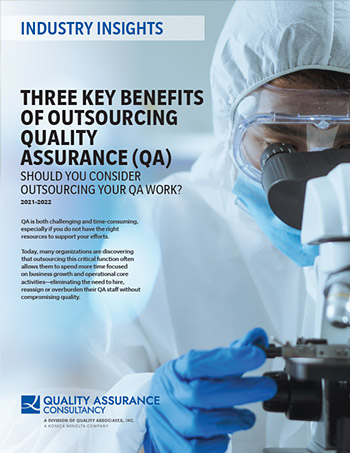Bioanalytical Audits
Quality Assurance Consultancy performed an independent bioanalytical audit of the bioanalytical data and bioanalytical phase report of scores of animal studies for this pharmaceutical drug sponsor company. The LC/MS bioanalyses had been performed at four separate laboratories. The review was performed directly on the analytical electronic data acquired using Analyst, as well as on the documented work-up of the samples. The goal was to verify that the expectations of the U.S. Food and Drug Administration (FDA) Guidance on Bioanalytical Method Validation were implemented for these studies. Specific focus was placed on:- Acceptability of the method validation results. Comparison between the use of the bioanalytical audit method during validation and during sample analysis were analyzed. Comparison between the validated storage durations at various stages of the method, and actual storage intervals during sample analysis also were analyzed.
- Adequacy of the data acquisition parameters of the analytes and their respective internal standard.
- Appropriateness of reintegrations of individual chromatograms. The audit trail of all batches was reviewed to identify possible reintegrations performed, and to compare with the laboratory standard operating procedures (SOP). Particular attention was placed on batches that failed acceptance before reintegration but passed afterwards.
- Possible contaminations, either in samples from control animals, or in samples collected before dosing. Other contaminations examined included those in solvent blanks interspersed during the run, as well as carry-over after the High QC or the ULOQ calibration samples.
Support
Investigative StudyQuality Assurance Consultancy performed an investigation at this bioanalytical laboratory for the possible cause of positive concentrations found in some samples of control animals and in some pre-dose samples of dosed animals. This investigation included a review of the sample receipt and storage procedures of the samples accession for work-up, and a complete review of all chromatographic data generated. The chromatograms were examined in Analyst and included a review of the audit trail, as well as an examination of the appropriate position of the baseline in the suspect samples. Data Audits
Our experts performed numerous data audits of bioanalytical data generated by this sponsor drug manufacturer. The LC/MS data were reviewed from sample work-up (often using automated liquid handling equipment, e.g., Tomtec) through the final database lock. The audits also included reviewing the preparation of every stock, intermediate, calibration and QC solutions prepared—and the verification that they were used within their validated storage duration. Challenges in these audits included:
- Several studies required rolling audits, where the data arrived for quality assurance (QA) audits the same day as they had been worked-up by the analyst, reviewed by the principal analytical investigator and approved by management. The audit of the last sets of data was expected to be completed immediately for database lock.
- One study included the analysis of 10 separate analytes (with their respective internal standards) in four separate analytical runs, in addition to possible dilution or repeat runs. The audit included verification that all samples had been analyzed properly for all analytes and that they did not exceed the validated storage duration and freeze-thaw cycles. The audit of this study’s data required the participation of three separate auditors, who were assigned specific analytical batches in the most time-efficient manner to meet the study deadlines.
Quality Assurance Consultancy performed a third-party audit of the bioanalytical data generated by MDS Pharma in Montreal, the quality control (QC) agent for the pharmaceutical sponsor company, as part of the requirement placed on sponsor companies to validate all data generated by this laboratory that supported an abbreviated new drug application (ANDA) submission. The goal of this audit was to verify the accuracy, scientific soundness and compliance with FDA regulations and guidance of four studies. The following methodology was followed:
- Verify all bioanalytical data for blank contaminations
- Review 100% of the study samples’, blanks’ and QC samples’ chromatography for acceptable baseline integration and for re-integrations identified in the audit trail
- Compare the reported samples concentrations with chromatographic results
- Compare the storage conditions and durations of samples, extracts and solutions with the validated stability evaluations
Outcome:
The findings of this audit were reported to the sponsor, who then successfully forwarded the report to the FDA.Training
Good Laboratory Practices (GLP) ReviewQuality Assurance Consultancy participated in the good laboratory practices (GLP) review of bioanalytical data using ELISA methods, part of the studies performed at this contract research organization (CRO). The review had been required by a client after the CRO was issued a warning letter by the FDA. All SOPs, final reports and raw data (paper and electronic) were reviewed to include bioanalytical ELISA data, test article use documentation and personnel records. Equipment records were reviewed to ensure that they were adequately tested, calibrated and standardized. QA inspection reports, master schedules, SOP and protocol deviations were also reviewed. Additionally, we helped a bioanalytical laboratory specializing in ELISA methods in setting up study protocols for the validation of these methods and for the analysis of samples in GLP studies. The support in the protocols’ design helped assure that the laboratory was following all directions of the FDA in the Guidance on Bioanalytical Method Validation for ligand-binding assays (LBA). Subsequently, our specialists conducted all QA activities during the conduct of these analyses, from protocol audits to final report audits. We also prepared training modules on the FDA Guidance on Bioanalytical Method Validation. These included two separate modules which were prepared separately for LC/MS methods and for ligand-binding assays (LBA):
- Bioanalytical Method Validation. This module discusses each test or requirement included in the FDA Guidance, with a detailed description of the batches to prepare, and the interpretation of the results. It also included description of the process to evaluate stability of the samples at every step of the sample work-up, some of which are not described in the FDA Guidance but may require consideration.
- Bioanalytical Sample Analysis. This module discussed the setup of sample analysis, the process to use for reintegrations, the interpretation and decision tree for sample reanalysis, and the set-up and interpretation of incurred sample reanalysis (ISR).


